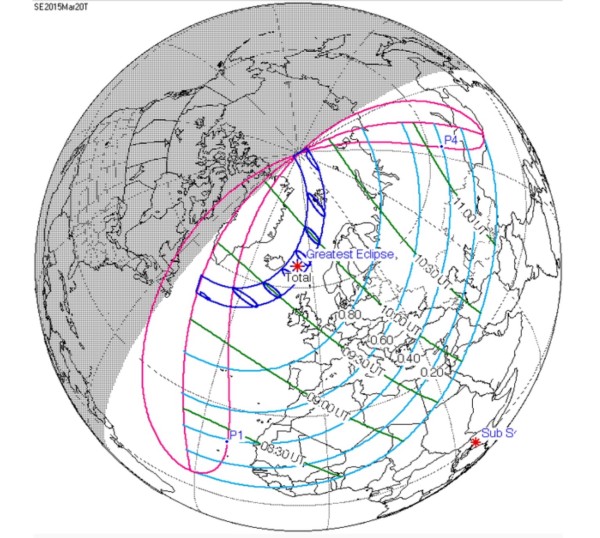One of the best solar eclipses of recent years for Europe — and the best in the UK in 16 years — is set to occur on Friday, March 20, 2015.
While totality will only be visible from Svalbard, Norway, and the Faroe Islands, the rest of Europe (as well as North Africa, Greenland, and West Asia) will still have a great show — providing the weather cooperates of course. Greatest eclipse will be at 9:46 UTC (coordinated universal time).
The UK, in particular, will play home to its deepest solar eclipse since all the way back in 1999 — with no comparable events coming again until 2026. As far as how deep — Edinburgh will see ~93% of the Sun’s disc covered by the Moon, the Shetlands will see ~ 97%, London ~85%, and percentages will diminish south and east of there.
In London maximum eclipse will be at 9:31 GMT (with the eclipse beginning at 8:25 GMT and ending at 10:41 GMT. The RAS and the Baker Street Irregular Astronomers will be hosting a free event in Regent’s Park giving access to “appropriate” viewing equipment for those interested.
A reminder on that front — looking directly at the Sun (staring especially) causes some damage to your eyesight (which you don’t notice at the time, as you have no nerves in the eye). Using special equipment (some of it cheap to make) greatly limits this though.
Something interesting to note — with Europe’s recent buildout of solar energy power plants, some countries will actually see power output fall pretty substantially during the eclipse. This will be mitigated by actions take by the regulating bodies in affected areas, but it’s still something interesting to think about.
Here’s some background information via our recent coverage:
“Total solar eclipses take place when the Earth, Moon and Sun are almost precisely aligned and the shadow of the Moon touches the surface of the Earth. At mid-eclipse, observers within the lunar shadow briefly see totality, where the silhouette of the Moon completely covers the Sun, revealing the beautiful outer solar atmosphere or corona. Totality is visible this time along a track a few hundred kilometres wide, which only intersects two landmasses, the Faroe Islands midway between Scotland and Iceland, and the arctic archipelago of Svalbard. Observers in those locations will see between two and two-and-a-half minutes of totality. Away from the path of the total eclipse the Sun is only partly obscured by the Moon.”
Taking all things into consideration, this will be the best solar eclipse for those in Europe to watch for some time — so if you have the time make sure you get out to see it! Here’s to hoping that the weather is good.
(For those interested in meteor showers, as well as eclipses, see: Meteor Showers 2015, Lyrids, Orionuds, Geminids, Leonids, Perseids, Draconids, Etc, Dates and Times)
Image Credit: Public Domain
